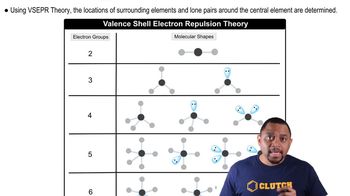Fill in the blank spaces in the following chart. If the molecule column is blank, find an example that fulfills the conditions of the rest of the row. Molecule Electron-Domain Hybridization Dipole Geometry of Central Atom Moment? Yes or No CO2 sp3 Yes sp3 No Trigonal planar No SF4 Octahedral No sp2 Yes Trigonal bipyramidal No XeF2 Complete the first row of the table.
Ch.9 - Molecular Geometry and Bonding Theories
Chapter 9, Problem 93b
An AB5 molecule adopts the geometry shown here. (b) Do you think there are any nonbonding electron pairs on atom A?

 Verified step by step guidance
Verified step by step guidance1
Identify the molecular geometry of the AB5 molecule shown in the image. The geometry appears to be trigonal bipyramidal.
Recall that in a trigonal bipyramidal geometry, the central atom (A) is surrounded by five atoms (B) with three atoms in the equatorial plane and two atoms in the axial positions.
Determine the electron domain geometry around the central atom (A). For a molecule with five bonding pairs and no lone pairs, the electron domain geometry is also trigonal bipyramidal.
Consider the presence of nonbonding electron pairs on the central atom (A). In a trigonal bipyramidal geometry, if there were any nonbonding electron pairs, they would occupy equatorial positions to minimize electron pair repulsion.
Conclude that since the molecule adopts a trigonal bipyramidal geometry with five bonding pairs and no lone pairs, there are no nonbonding electron pairs on atom A.

Verified Solution
Video duration:
2mWas this helpful?
Key Concepts
Here are the essential concepts you must grasp in order to answer the question correctly.
Molecular Geometry
Molecular geometry refers to the three-dimensional arrangement of atoms within a molecule. In the case of an AB5 molecule, where 'A' is the central atom and 'B' represents five surrounding atoms, the geometry is typically trigonal bipyramidal. Understanding this geometry is crucial for predicting the spatial orientation of the atoms and the potential presence of lone pairs.
Recommended video:
Guided course

Molecular Geometry with Two Electron Groups
VSEPR Theory
Valence Shell Electron Pair Repulsion (VSEPR) theory is a model used to predict the geometry of molecules based on the repulsion between electron pairs in the valence shell of the central atom. According to VSEPR, electron pairs, whether bonding or nonbonding, will arrange themselves to minimize repulsion, which helps determine the molecular shape and the presence of lone pairs.
Recommended video:
Guided course

Molecular Shapes and VSEPR
Lone Pairs
Lone pairs are pairs of valence electrons that are not involved in bonding and are localized on a single atom. In the context of the AB5 molecule, the presence of lone pairs on atom A would influence its geometry and the angles between the surrounding B atoms. Identifying lone pairs is essential for accurately predicting molecular shape and reactivity.
Recommended video:
Guided course

Lone Pair Positions
Related Practice
Textbook Question
582
views
Open Question
From their Lewis structures, determine the number of σ and π bonds in each of the following molecules or ions: (a) hydrazine, N2H4 (b) hydrogen cyanide, HCN (c) sulphur trioxide, SO3
Textbook Question
Ethyl propanoate, CH3CH2COOCH2CH3, gives a fruity pineapple-like smell. (e) What are the approximate bond angles around each carbon atom in the molecule?
2383
views
Textbook Question
An AB5 molecule adopts the geometry shown here. (c) Suppose the B atoms are halogen atoms. Of which group in the periodic table is atom A a member: (i) Group 15, (ii) Group 16, (iii) Group 17, (iv) Group 18, or (v) More information is needed?
618
views
Textbook Question
The O¬H bond lengths in the water molecule 1H2O2 are 96 pm, and the H¬O¬H angle is 104.5°. The dipole moment of the water molecule is 1.85 D. (b) Calculate the magnitude of the bond dipole of the O¬H bonds. (Note: You will need to use vector addition to do this.)
2063
views
2
rank
Textbook Question
a) Predict the electron-domain geometry around the central S atom in SF2, SF4, and SF6.
701
views
